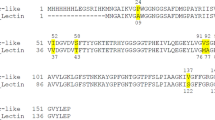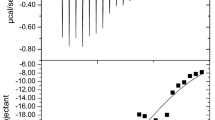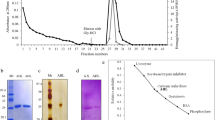Abstract
The Tn antigen (GalNAc-O-Ser/Thr) is one of the most specific human cancer-associated structures. In the present study we characterize the biochemical and functional properties of the Myrsine coriacea lectin (McL). We show that McL is an unusual high molecular weight highly glycosylated protein, which displays a strong Tn binding activity. The lectin exhibits in vitro inhibition of proliferation in the six cancer cell lines evaluated, in a dose-dependent manner (the strongest activity being against HT-29 and HeLa cells), whereas it does not exhibit toxicity against normal lymphocytes. McL could be exploited in the design of potential new tools for the diagnosis or treatment of cancer.

Similar content being viewed by others
References
Baldus SE, Engelmann K, Hanisch FG (2004) MUC1 and the MUCs: a family of human mucins with impact in cancer biology. Crit Rev Clin Lab Sci 41:189–231
Iwai T, Kudo T, Kawamoto R, Kubota T, Togayachi A, Hiruma T, Okada T, Kawamoto T, Morozumi K, Narimatsu H (2005) Core 3 synthase is down-regulated in colon carcinoma and profoundly suppresses the metastatic potential of carcinoma cells. Proc Natl Acad Sci 102:4572–4577
Lis H, Sharon N (1998) Lectins: carbohydrate-specific proteins that mediate cellular recognition. Chem Rev 98:637–674
Abbott KL, Pierce JM (2010) Lectin-based glycoproteomic techniques for the enrichment and identification of potential biomarkers. Methods Enzymol 480:461–476
Liu B, Bian HJ, Bao JK (2010) Plant lectins: potential antineoplastic drugs from bench to clinic. Cancer Lett 287:1–12
Lei HY, Chang CP (2010) Lectin of concanavalin A as an anti-hepatoma therapeutic agent. J Biomed Sci 16:10
Zhou XX, Ji F, Zhao JL, Cheng LF, Xu CF (2010) Anti-cancer activity of anti-p185HER-2 ricin A chain immunotoxin on gastric cancer cells. J Gastroenterol Hepatol 25:1266–1275
Fu LL, Zhou CC, Yao S, Yu JY, Liu B, Bao JK (2011) Plant lectins: targeting programmed cell death pathways as antitumor agents. Int J Biochem Cell Biol 43:1442–1449
Bakowsky H, Richter T, Kneuer C, Hoekstra D, Rothe U, Bendas G, Ehrhardt C, Bakowsky U (2008) Adhesion characteristics and stability assessment of lectin-modified liposomes for site-specific drug delivery. Biochim Biophys Acta 1778:242–249
Wang C, Ho PC, Lim LY (2010) Wheat germ agglutinin-conjugated PLGA nanoparticles for enhanced intracellular delivery of paclitaxel to colon cancer cells. Int J Pharm 400:201–210
Hollingsworth MA, Swanson BJ (2004) Mucins in cancer: protection and control of the cell surface. Nat Rev Cancer 4:45–60
Brockhausen I (2006) Mucin-type O-glycans in human colon and breast cancer: glycodynamics and functions. EMBO Rep 7:599–604
Springer G (1984) T and Tn, general carcinoma autoantigens. Science 224:1198–1206
Ju T, Otto VI, Cummings RD (2011) The Tn antigen—structural simplicity and biological complexity. Angew Chem Int Ed Engl 50:1770–1791
Lo-Man R, Vichier-Guerre S, Perraut R, Deriaud E, Huteau V, BenMohamed L, Diop OM, Livingston PO, Bay S, Leclerc C (2004) A fully synthetic therapeutic vaccine candidate targeting carcinoma-associated Tn carbohydrate antigen induces tumor-specific antibodies in nonhuman primates. Cancer Res 64:4987–4994
Galonic D, Gin D (2007) Chemical glycosylation in the synthesis of glycoconjugate antitumour vaccines. Nature 446:1000–1007
Tarp MA, Clausen H (2008) Mucin-type O-glycosylation and its potential use in drug and vaccine development. Biochim Biophys Acta 1780:546–563
Puri KD, Gopalakrishnan B, Surolia A (1992) Carbohydrate binding specificity of the Tn-antigen binding lectin from Vicia villosa seeds. FEBS Lett 312:208–212
Piller V, Piller F, Cartron J-P (1986) Isolation and characterization of an N-acetylgalactosamine specific lectin from Salvia sclarea seeds. J Biol Chem 261:14069–14075
Wu AM, Wu JH, Chen Y-Y, Song S-C, Kabat EA (1999) Further characterization of the combining site of Bandeiraea (Griffonia) simplicifolia lectin-1, isolectin A4 (GSI-A4). Glycobiology 9:1161–1170
Osinaga E, Tello D, Batthyany C, Bianchet M, Tavares G, Duran R, Cervenansky C, Camoin L, Roseto A, Alzari P (1997) Amino acid sequence and three-dimensional structure of the Tn-specific isolectin B4 from Vicia villosa. FEBS Lett 412:190–196
Babino A, Tello D, Rojas A, Bay S, Osinaga E, Alzari PM (2003) The crystal structure of a plant lectin in complex with the Tn antigen. FEBS Lett 536:106–110
Medeiros A, Bianchi S, Calvete JJ, Balter H, Bay S, Robles A, Cantacuzéne D, Nimtz M, Alzari PM, Osinaga E (2000) Biochemical and functional characterization of the Tn-specific lectin from Salvia sclarea. Eur J Biochem 267:1434–1440
Osinaga E, Bay S, Tello D, Babino A, Pritsch O, Assemat K, Cantacuzene D, Nakada H, Alzari P (2000) Analysis of the fine specificity of Tn-binding proteins using synthetic glycopeptide epitopes and a biosensor based on surface plasmon resonance spectroscopy. FEBS Lett 469:24–28
Medeiros A, Plá A, Alonso E, Batista-Viera F, Osinaga E, Franco Fraguas L (2005) Identification of a high-molecular-weight glycoconjugate from a Uruguayan plant that binds to the tumor-associated Tn antigen. Pharm Biol 43:26–32
Edge ASB, Faltynek CR, Hof L, Reichert LE Jr, Weber P (1981) Deglycosylation of glycoproteins by trifluoromethanesulfonic acid. Anal Biochem 118:131–137
Vichier-Guerre S, Lo-Man R, Bay S, Deriaud E, Nakada H, Leclerc C, Cantacuzene D (2000) Short synthetic glycopeptides successfully induce antibody responses to carcinoma-associated Tn antigen. J Pept Res 55:173–180
Malmqvist M (1993) Biospecific interaction analysis using biosensor technology. Nature 361:186–187
Jönsson U, Fägerstam L, Ivarsson B, Johnsson B, Karlsson R, Lundth K, Löfas S, Persson B, Ross H, Rönnberg I, Sjölander S, Stenberg E, Stahlberg R, Urbaniczky S, Östlin H, Malmqvist M (1991) Real-time biospecific interaction analysis using surface plasmon resonance and a sensor chip technology. Bio Tech 11:620–627
Ho JCK, Sze SCW, Shen WZ, Liu WK (2004) Mitogenic activity of edible mushroom lectins. Biochim Biophys Acta 1671:9–17
Kellokumpu IH (1986) Differences in lectin reactivities of cellular glycoconjugates between primary human colorectal carcinomas and their metastases. Cancer Res 46:4620–4625
Itzkowitz SH, Yuan M, Montgomery CK, Kjeldsen T, Takahashi HK, Bigbee WL, Kim YS (1989) Gastrointestinal Expression of Tn, sialosyl-Tn, and T antigens in human colon cancer. Cancer Res 49:197–204
Chen YF, Boland CR, Kraus ER, Goldstein IJ (1994) The lectin Griffonia simplicifolia I-A4 (GS I-A4) specifically recognizes terminal alpha-linked N-acetylgalactosaminyl groups and is cytotoxic to the human colon cancer cell lines LS174t and SW1116. Int J Cancer 57:561–567
Nishiyama T, Matsumoto Y, Watanabe H, Fujiwara M, Sato S (1987) Detection of Tn antigen with Vicia villosa agglutinin in urinary bladder cancer: its relevance to the patient’s clinical course. J Natl Cancer Inst 78:1113–1118
Terasawa K, Furumoto H, Kamada M, Aono T (1996) Expression of Tn and sialyl-Tn antigens in the neoplastic transformation of uterine cervical epithelial cells. Cancer Res 56:2229–2232
Konno A, Hoshino Y, Terashima S, Motoki R, Kawaguchi T (2002) Carbohydrate expression profile of colorectal cancer cells is relevant to metastatic pattern and prognosis. Clin Exp Metastasis 19:61–70
Kawaguchi T, Takazawa H, Imai S, Morimoto J, Watanabe T, Kanno M, Igarashi S (2006) Expression of Vicia villosa agglutinin (VVA)-binding glycoprotein in primary breast cancer cells in relation to lymphatic metastasis: is atypical MUC1 bearing Tn antigen a receptor of VVA? Breast Cancer Res Treat 98:31–43
De Mejia EG, Prisecaru VI (2005) Lectins as bioactive plant proteins: a potential in cancer treatment. Crit Rev Food Sci Nutr 45:425–445
Marth C, Daxenbichler G (1988) Peanut agglutinin inhibits proliferation of cultured breast cancer cells. Oncology 45:47–50
Ryder SD, Smith JA, Rhodes JM (1992) Peanut lectin: a mitogen for normal human colonic epithelium and human HT29 colorectal cancer cells. J Natl Cancer Inst 84:1410–1416
Li WW, Yu JY, Xu HL, Bao JK (2011) Concanavalin A: a potential anti-neoplastic agent targeting apoptosis, autophagy and anti-angiogenesis for cancer therapeutics. Biochem Biophys Res Commun 414:282–286
Remmelink M, Darro F, Decaestecker C, De Decker R, Bovin NV, Gebhart M, Kaltner H, Gabius HJ, Kiss R, Salmon I, Danguy A (1999) In vitro influence of lectins and neoglycoconjugates on the growth of three human sarcoma cell lines. J Cancer Res Clin Oncol 125:275–285
Singh T, Wu JH, Peumans WJ, Rougé P, Van Damme EJ, Alvarez RA, Blixt O, Wu AM (2006) Carbohydrate specificity of an insecticidal lectin isolated from the leaves of Glechoma hederacea (ground ivy) towards mammalian glycoconjugates. Biochem J 393:331–341
Wang W, Hause B, Peumans WJ, Smagghe G, Mackie A, Fraser R, Van Damme EJM (2003) The Tn antigen-specific lectin from ground ivy is an insecticidal protein with an unusual physiology. Plant Physiol 132:1322–1334
Gastman B, Wang K, Han J, Zhu ZY, Huang X, Wang GQ, Rabinowich H, Gorelik E (2004) A novel apoptotic pathway as defined by lectin cellular initiation. Biochem Biophys Res Commun 316:263–271
Hubert P, Heitzmann A, Viel S, Nicolas A, Sastre-Garau X, Oppezzo P, Pritsch O, Osinaga E, Amigorena S (2011) Antibody-dependent cell cytotoxicity synapses form in mice during tumor-specific antibody immunotherapy. Cancer Res 71:5134–5143
Apostolopoulos V, Yuriev E, Ramsland PA, Halton J, Osinski C, Li W, Plebanski M, Paulsen H, McKenzie IF (2003) A glycopeptide in complex with MHC class I uses the GalNAc residue as an anchor. Proc Natl Acad Sci U S A 100:15029–15034
Xu Y, Gendler SJ, Franco A (2004) Designer glycopeptides for cytotoxic T cell-based elimination of carcinomas. J Exp Med 199:707–716
Lakshminarayanan V, Thompson P, Wolfert MA, Buskas T, Bradley JM, Pathangey LB, Madsen CS, Cohen PA, Gendler SJ, Boons GJ (2012) Immune recognition of tumor-associated mucin MUC1 is achieved by a fully synthetic aberrantly glycosylated MUC1 tripartite vaccine. Proc Natl Acad Sci U S A 109:261–266
Acknowledgments
We thank Drs. Juan José Calvete, Henia Balter, Silvia Soulé, Luis Ubillos and Mrs. Paola Mora for technical assistance. We thank Dr. Gloria Serra for providing us with mitomycin. This work was partially supported by the Comisión Honoraria de Lucha Contra el Cáncer (Uruguay), CSIC-Grupos de Investigación grant (Uruguay), and Program for Development of Basic Sciences (PEDECIBA-Química).
Author information
Authors and Affiliations
Corresponding author
Electronic supplementary material
Below is the link to the electronic supplementary material.
Rights and permissions
About this article
Cite this article
Medeiros, A., Berois, N., Incerti, M. et al. A Tn antigen binding lectin from Myrsine coriacea displays toxicity in human cancer cell lines. J Nat Med 67, 247–254 (2013). https://doi.org/10.1007/s11418-012-0671-x
Received:
Accepted:
Published:
Issue Date:
DOI: https://doi.org/10.1007/s11418-012-0671-x




